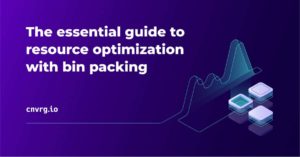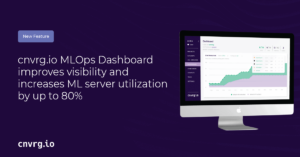This tutorial will help you set up TensorFlow 1.12 on Ubuntu 16.04 with a GPU using Docker and Nvidia-docker.
TensorFlow is one of the most popular deep-learning libraries. It was created by Google and was released as an open-source project in 2015. TensorFlow is used for both research and production environments. Installing TensorFlow can be cumbersome. The difficulty varies based on your environment constraints, and more when you’re a data scientist that just wants to build your neural networks.
When using TensorFlow on GPU – setting up requires a few steps. In the following tutorial, we will go over the process required to setup TensorFlow.
Requirements:
- NVIDIA GPU Machine
- Docker and Nvidia-Docker installed. (Read “How to install docker and nvidia-docker in our blog)
- Ubuntu 16.04
Step 1 – Prepare your environment with Docker and Nvidia-Docker
Docker is a tool designed to make it easier to create, deploy, and run applications by using containers. What exactly is a container? Containers allow data scientists and developers to wrap up an environment with all of the parts it needs – such as libraries and other dependencies – and ship it all out in one package.
To use docker with GPUs and to be able to use TensorFlow in your application, you’ll need to install Docker with Nvidia-Docker. If you already have those installed, move to the next step. Otherwise, you can follow our previous guide to installing nvidia docker.
Prerequisites
Step 2 – Dockerfile
Docker can build images (environments) automatically by reading the instructions from a Dockerfile. A Dockerfile is a text document that contains all the commands a user could call on the command line to assemble an image.
In our case, those commands will describe the installation of Python 3.6, CUDA 9 and CUDNN 7.2.1 – and of course the installation of TensorFlow 1.12 from source.
For this environment, we will use the following Dockerfile, which you can find here
Step 3 – Running Dockerfile
To build the image from the Dockerfile, simply run the docker build command. Keep in mind that this build process might take a few hours to complete. We recommend using nohup utility so that if your terminal hangs – it will still run.
$ docker build -t deeplearning -f Dockerfile
This should output the setup process and should end with something similar to:
>> Successfully built deeplearning (= the image ID)
Your image is ready to use. To start the environment, simply type in the below command. But, don’t forget to replace your image id:
$ docker run --runtime=nvidia -it deeplearning /bin/bash
Step 4 – Validating TensorFlow & start building!
Validate that TensorFlow is indeed running in your Dockerfile
$ python
>> import tensorflow as tf
>> sess = tf.Session(config=tf.ConfigProto(log_device_placement=True))
2019-02-23 07:34:14.592926: I
tensorflow/core/platform/cpu_feature_guard.cc:141] Your CPU supports
instructions that this TensorFlow binary was not compiled to use: AVX2 FMA
2019-02-23 07:34:17.452780: I
tensorflow/stream_executor/cuda/cuda_gpu_executor.cc:964] successful NUMA
node read from SysFS had negative value (-1), but there must be at least
one NUMA node, so returning NUMA node zero
2019-02-23 07:34:17.453267: I
tensorflow/core/common_runtime/gpu/gpu_device.cc:1432] Found device 0 with
properties:
name: Tesla K80 major: 3 minor: 7 memoryClockRate(GHz): 0.8235
pciBusID: 0000:00:1e.0
totalMemory: 11.17GiB freeMemory: 11.10GiB
2019-02-23 07:34:17.453306: I
tensorflow/core/common_runtime/gpu/gpu_device.cc:1511] Adding visible gpu
devices: 0
2019-02-23 07:34:17.772969: I
tensorflow/core/common_runtime/gpu/gpu_device.cc:982] Device interconnect
StreamExecutor with strength 1 edge matrix:
2019-02-23 07:34:17.773032: I
tensorflow/core/common_runtime/gpu/gpu_device.cc:988] 0
2019-02-23 07:34:17.773054: I
tensorflow/core/common_runtime/gpu/gpu_device.cc:1001] 0: N
2019-02-23 07:34:17.773403: I
tensorflow/core/common_runtime/gpu/gpu_device.cc:1115] Created TensorFlow
device (/job:localhost/replica:0/task:0/device:GPU:0 with 10757 MB memory)
-> physical GPU (device: 0, name: Tesla K80, pci bus id: 0000:00:1e.0,
compute capability: 3.7)
Device mapping:
/job:localhost/replica:0/task:0/device:XLA_CPU:0 -> device: XLA_CPU device
/job:localhost/replica:0/task:0/device:XLA_GPU:0 -> device: XLA_GPU device
/job:localhost/replica:0/task:0/device:GPU:0 -> device: 0, name: Tesla K80,
pci bus id: 0000:00:1e.0, compute capability: 3.7
2019-02-23 07:34:17.774289: I
tensorflow/core/common_runtime/direct_session.cc:307] Device mapping:
/job:localhost/replica:0/task:0/device:XLA_CPU:0 -> device: XLA_CPU device
/job:localhost/replica:0/task:0/device:XLA_GPU:0 -> device: XLA_GPU device
/job:localhost/replica:0/task:0/device:GPU:0 -> device: 0, name: Tesla K80,
pci bus id: 0000:00:1e.0, compute capability: 3.7
Congrats! Your new TensorFlow environment is set up and ready to start training, testing and deploying your deep learning models!








